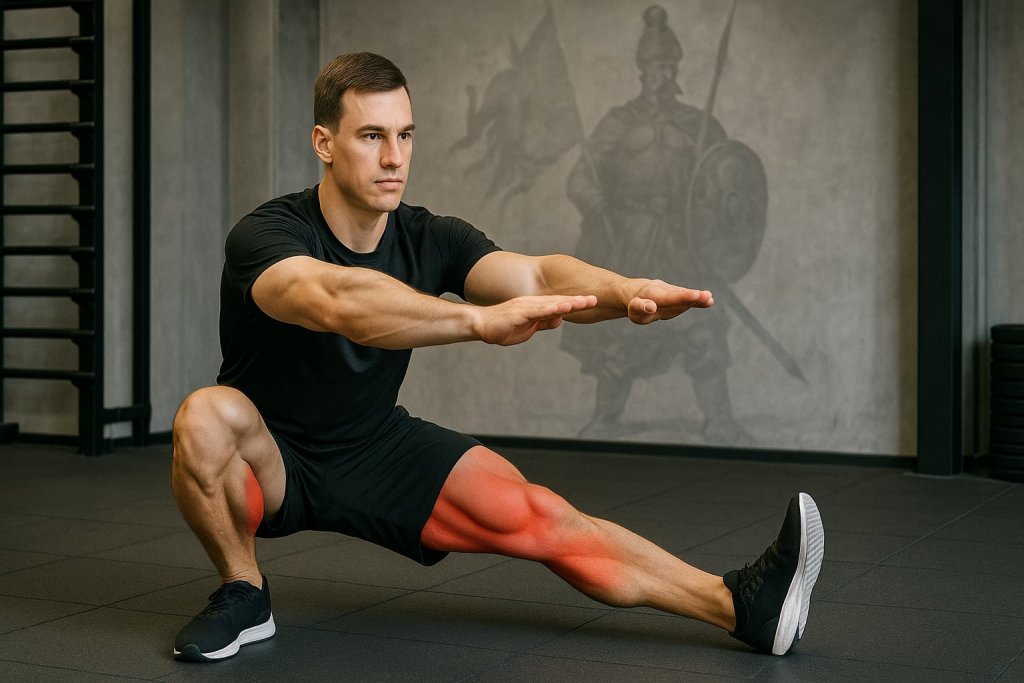Forget lunges—there’s a smarter way to build lower-body strength and mobility.
The Cossack squat trains your legs, hips, and core while opening up tight joints in ways lunges can’t. This side-to-side deep squat improves strength, balance, and flexibility—all in one movement—making it a joint-friendly alternative for anyone who finds forward lunges uncomfortable.
In this guide, you’ll learn exactly how to do the Cossack squat with perfect form, the muscles it works, its benefits, variations for all skill levels, common mistakes to avoid, and expert tips to get the most out of every rep.

What Is the Cossack Squat?
The Cossack squat is a side-to-side deep squat performed with one leg bent and the other extended, heel on the floor, toes up. It trains strength, mobility, and stability in the hips, knees, and ankles while stretching your lower body in the frontal plane—a movement often neglected in traditional training.
This move is named after the Cossack warriors of Eastern Europe, who used it for mobility and combat readiness.
How to Do the Cossack Squat (Step-by-Step)
- Set Up
- Stand with your feet wider than shoulder-width apart.
- Toes slightly turned out, chest upright.
- Shift & Lower
- Shift your weight onto one leg.
- Bend that knee deeply while keeping the other leg straight.
- Foot Position
- On the straight leg, keep your heel on the ground and toes pointing up.
- Depth & Posture
- Squat down as far as mobility allows, keeping your chest tall.
- Your hips should drop below knee level if possible.
- Return
- Push through the bent leg to return to the starting position.
- Repeat on the other side.
Pro Tip: Extend your arms forward for balance or hold a light weight for counterbalance.
Muscles Worked
The Cossack squat is both a strength and flexibility exercise, targeting:
- Quadriceps (primary driver on the bent leg)
- Gluteus Maximus & Medius (hip extension and stability)
- Adductors (deep stretch on the straight leg)
- Hamstrings (eccentric stretch)
- Calves & Tibialis Anterior (ankle stability)
- Core Muscles (balance and posture support)
Benefits of the Cossack Squat

1. Improves Hip, Knee & Ankle Mobility
Deep side squats enhance flexibility in multiple joints, making movements like squats and lunges feel easier.
2. Builds Strength in Multiple Planes
Trains frontal plane movement (side-to-side) often missed in traditional training, improving athletic performance.
3. Enhances Balance & Stability
Strengthens stabilizers and coordination for sports and daily movement.
4. Transfers to Better Squats & Deadlifts
Addresses mobility restrictions and asymmetries, boosting performance in other lifts.
5. Joint-Friendly Alternative to Lunges
Puts less strain on the knees compared to forward lunges, making it great for people with mild knee discomfort.
Common Mistakes to Avoid
- Raising the Heel of the Bent Leg — Often due to tight ankles; use mobility drills to improve.
- Leaning Too Far Forward — Keep the torso upright to avoid excessive lower-back strain.
- Overstretching Too Soon — Gradually increase range to avoid groin injuries.
- Skipping Warm-Up — Always prepare hips, knees, and ankles before going deep.
Cossack Squat Variations
- Assisted Cossack Squat – Hold onto TRX straps or a stable object.
- Counterbalance Squat – Hold a kettlebell or plate at chest height.
- Elevated Foot Version – Place your straight leg on a low box for reduced mobility demands.
- Loaded Cossack Squat – Add a dumbbell, kettlebell, or barbell for strength progression.
- Landmine Cossack Squat – Great for controlled resistance and posture improvement.
Alternatives to the Cossack Squat
- Side Lunges – Similar movement with less flexibility demand.
- Lateral Step-Ups – Builds frontal plane strength using a bench or step.
- Jefferson Curls – Improves hamstring mobility.
- Skater Squats – Unilateral strength without heavy hip mobility requirements.
Who Should Do the Cossack Squat?
- Strength Athletes – Powerlifters & weightlifters to improve squat depth and mobility.
- Athletes in Lateral Sports – Basketball, tennis, soccer players for side-to-side agility.
- Rehabilitation Clients – Those needing gradual mobility improvement post-injury (with professional guidance).
- Fitness Enthusiasts – Anyone seeking a functional, joint-friendly lower-body move.
Trainer Tips for Success
- Warm up with hip openers and ankle dorsiflexion drills.
- Start bodyweight only before progressing to added weight.
- Move slowly and deliberately—control is more important than speed.
- Use a mirror or video to check form.
- Focus on symmetry—avoid over-relying on your dominant side.
FAQs
Is the Cossack squat good for knee health?
When progressed gradually and kept pain‑free, it can strengthen the quads/adductors and improve hip‑knee alignment. Keep the squatting heel down and the knee tracking over the middle toes.
Can I replace lunges with Cossacks?
Yes, if lunges irritate your knees, Cossacks offer similar unilateral and frontal‑plane benefits with more control over depth and ankle angle (field notes).
What if my heel lifts or I can’t get low?
Reduce depth, elevate the straight leg on a low step, and add ankle/hip mobility work. Use assistance (pole/TRX) until you can keep the foot flat.
Conclusion
The Cossack squat is a must-have exercise for anyone looking to boost mobility, build lower-body strength, and improve athletic performance. Whether you’re an athlete, weightlifter, or casual gym-goer, mastering this move will unlock new ranges of motion and strength you didn’t know you had.
